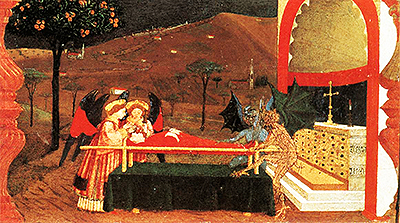The Miracle of the Desecrated Host is a series of art panels, originally designed to sit below the altar (predella) of the Corpus Domini church in Urbino.
The work was commissioned in 1467, by a brotherhood of the church, with completion and final payment made in 1469. It is believed that the artist got inspired by the teachings of Bernardino of Siena, a Franciscan missionary. The set of six pieces line up to tell the story of a 13th-century tale, where a Jewish man is accused of desecrating a consecrated host. The Jew buys a host from a Christian woman and decides to test if what Christians say about the mistreatment of the sacred host is true:
- He tries to pierce it, but it starts bleeding.
- Tries to burn it and fails.
- He then throws it into boiling water, but the water turns bloody, and the host transforms in the crucified body of Jesus Christ.
The series of miracles alert the guards, who storm in to rescue the host. A procession is planned to re-consecrate the host, while the Jewish trader and his family are executed by burning. The woman repents but she is still executed, and Scene 4 shows an angel coming to save her. Scene Six from The Miracle of the Desecrated Host depicts two angels and two demons arguing over the woman’s body. The work is currently displayed at the National Gallery of the Marche in Urbino.
It is amazing how Paolo Uccello's colourful imagery enliven an otherwise dark topic. His pieces have always inspired profound thoughts into the subjects being addressed. A similar thing can be experienced in his greatest work ever, The Battle of San Romano. The series of three paintings, depicting various scenes at the battle, are currently separated and displayed at different art galleries in Florence, Paris, and London. Other notable works by the artist include the paintings of the Annunciation (1425), the Crucifixion, Saint George and the Dragon, and The Thebaid (Life of the Holy Fathers), among others.
Paolo’s work draws much inspiration from his original mentor, Lorenzo Ghiberti, a Florentine sculptor. Lorenzo Ghiberti worked on the eastern doors of the Baptistery of Saint John in Florence. An awestruck Michelangelo compared them to the gates of paradise.




